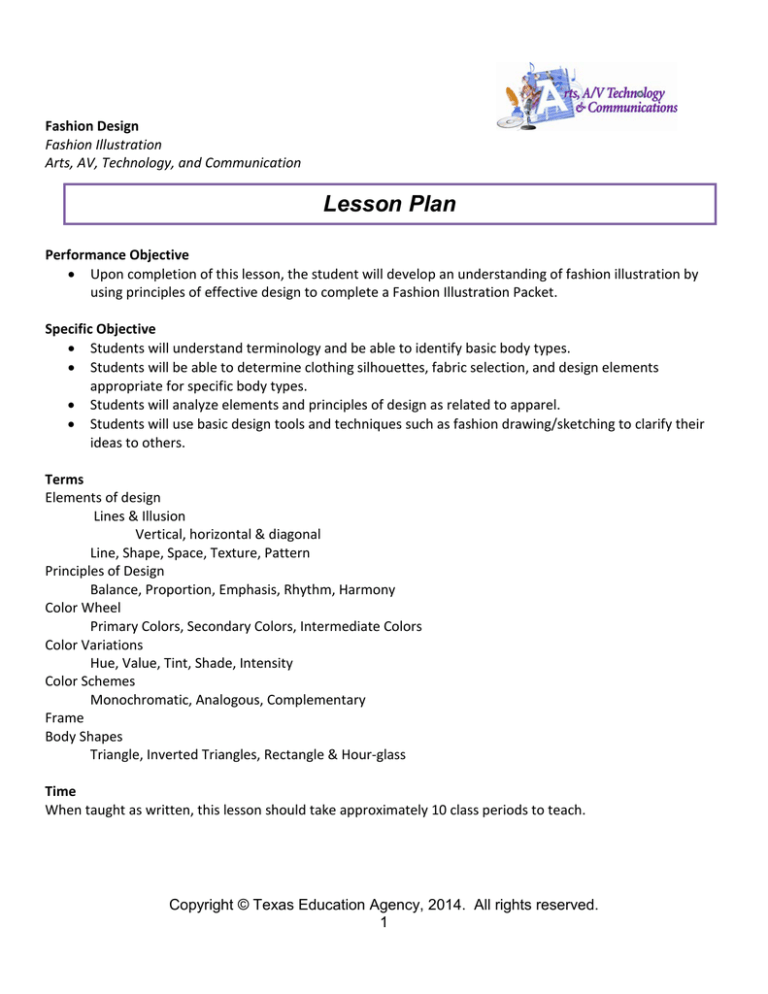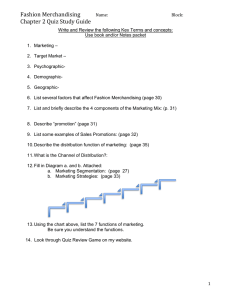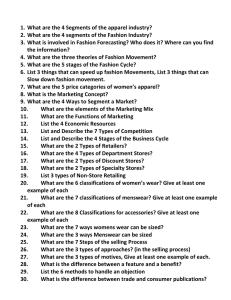Lesson Plan
advertisement

Fashion Design Fashion Illustration Arts, AV, Technology, and Communication Lesson Plan Performance Objective • Upon completion of this lesson, the student will develop an understanding of fashion illustration by using principles of effective design to complete a Fashion Illustration Packet. Specific Objective • Students will understand terminology and be able to identify basic body types. • Students will be able to determine clothing silhouettes, fabric selection, and design elements appropriate for specific body types. • Students will analyze elements and principles of design as related to apparel. • Students will use basic design tools and techniques such as fashion drawing/sketching to clarify their ideas to others. Terms Elements of design Lines & Illusion Vertical, horizontal & diagonal Line, Shape, Space, Texture, Pattern Principles of Design Balance, Proportion, Emphasis, Rhythm, Harmony Color Wheel Primary Colors, Secondary Colors, Intermediate Colors Color Variations Hue, Value, Tint, Shade, Intensity Color Schemes Monochromatic, Analogous, Complementary Frame Body Shapes Triangle, Inverted Triangles, Rectangle & Hour-glass Time When taught as written, this lesson should take approximately 10 class periods to teach. Copyright © Texas Education Agency, 2014. All rights reserved. 1 Preparation TEKS Correlations: This lesson, as published, correlates to the following TEKS. Any changes/alterations to the activities may result in the elimination of any or all of the TEKS listed. 130.93. (C) Knowledge and Skills 10) The student develops an understanding of fashion and the textile and apparel industries. The student is expected to: (H) Design apparel products using principles of effective design by: (i) identifying basic body types; (ii) determining clothing silhouettes, fabric selection, and design elements appropriate for specific body types; (iii) using design elements and principles to design products for the human form, including adaptations for individuals with special needs; (iv) using basic design tools and techniques such as fashion drawing, draping, and flat pattern methods for fitting a garment (I) Analyze the apparel production process from design concept to finished product by: (i) analyzing elements and principles of design as related to apparel (ii) outlining the apparel production process Interdisciplinary Correlations: English-English I • 130.93(c)(1)(A). Apply English language arts knowledge and skills by demonstrating use of content technical concepts, and vocabulary; • 130.93(c)(2)(e,f). Students will apply active listening skills; listen to and speak with diverse individuals Occupational Correlation (O*Net – www.onetonline.org/): Job Title: Fashion Designer O*Net Number: 27-1022.00 Reported Job Titles: Apparel Fashion Designer, Clothing Designer, Costume Designer, Design Director Tasks: • • • • • • • Direct and coordinate workers involved in drawing and cutting patterns and constructing samples or finished garments. Examine sample garments on and off models, modifying designs to achieve desired effects. Sketch rough and detailed drawings of apparel or accessories, and write specifications such as color schemes, construction, material types, and accessory requirements. Confer with sales and management executives or with clients to discuss design ideas. Identify target markets for designs, looking at factors such as age, gender, and socioeconomic status. Attend fashion shows and review garment magazines and manuals to gather information about fashion trends and consumer preferences. Select materials and production techniques to be used for products. Copyright © Texas Education Agency, 2014. All rights reserved. 2 Soft Skills: Active Listening, Speaking, Communication Accommodations for Learning Differences It is important that lessons accommodate the needs of every learner. These lessons may be modified to accommodate your students with learning differences by referring to the files found on the Special Populations page of this website. Preparation • Review and familiarize yourself with the terminology, croquis, and proper sketching & texture techniques. • Download the slide presentation to preview material ahead of time • Have a completed sample of a Fashion Illustration Packet to show your students • Have materials, slide presentation, and any reference books ready to go prior to the start of the lesson. • Be sure to search online for videos that you feel would best fit your students’ learning style • Provide appropriate video links for your students so they can practice outside of class. • Talk with your school’s art teacher and collaborate with the art department by having some of their AP or upper level drawing students come into your classroom for two days to work with students in small groups. References 1. Weber, J. (2008). Clothing: Fashion, fabrics & construction (4th ed.). New York, NY: Glencoe/McGrawHill. 2. Search online for ‘free croquis’, or templates. Some of the first sites that pop up are usually easy to print from for your students. Instructional Aids • Clothing textbook (above) or any other resource that may provide information on illustration & fashion design • Lesson - Fashion Illustration • Slide presentation – Fashion Illustration • Student Instructional Handout • Fashion Illustration Rubric • Instructor Computer/Projection Unit • Online websites (teacher directed) • Computer paper, pencils, croquis, erasers, map pencils, ruler Introduction Introduce the lesson by showing pictures (hard copies or online) and/or videos of some current fashions. Ask students if they can identify some of the elements or characteristics that would make these particular fashions appealing and marketable. Copyright © Texas Education Agency, 2014. All rights reserved. 3 Explain that over the next 10 days, students will learn about design principles and how to use design tools and techniques to create their own Fashion Illustration Packet. 1. Divide students into groups of 4 or less. 2. Make sure each individual has their binder including: Journal, Notebook paper, computer paper, pencils, ruler, and the Student Instructional Handout. 3. Inform students that over the next ten days, they will analyze multiple aspects of color, principles & elements of design, and explain how they correlate to the fashion drawing/sketching design. 4. Students will do a series of preliminary sketches and then complete a Fashion Illustration Packet with four sketch designs. 5. The instructor will use the first 20 minutes of each day to explain a concept using the Fashion Illustration slide presentation. 6. The last 25 minutes of each class period will be used for students to practice their sketching/illustration skills. 7. The tenth day will be used to make any final touches to students’ Fashion Illustration Packet and to present their projects for display and assessment. Outline MI Outline I. What is Fashion? A. Respond in journals B. Discuss or debate in groups II. Body Basics A. Frame is determined by the ratio of a person’s height to wrist measurement. B. Frame sizes include small, medium, and large. III. Four Basic Body Shapes A. Triangle B. Inverted triangle C. Hourglass D. Ruler IV. Triangle Body Shape A. Hips are the widest part of the body B. Sometimes referred to as a “pear shape” V. Inverted Triangle Body Shape Instructor Notes Allow students time to write in their journal; then debate the different viewpoints. After talking about the different frame sizes, let the students discuss how frame visually affects your appearance. Use the National Library of Medicine guidelines so students may take their measurements and learn their frame size. The measurements are in the teacher note section of the slide presentation. Use a search engine to find pictures of current celebrities or people your students will know to illustrate the different body shapes. Copyright © Texas Education Agency, 2014. All rights reserved. 4 MI Outline Instructor Notes A. Chest and waist are the largest parts of the body B. Often seen in athletes and swimmers C. Sometimes referred to as the “apple shape” VI. Hourglass Body Shape A. Chest and hips are almost equal measurements B. Waist is the smallest part of the body VII. Rectangle Body Shape A. Chest, waist, and hips are almost equal in measurements B. Seen most often in runners C. Often referred to as the “ruler shape” VIII. Understanding Lines and Illusions A. Vertical lines lead the eye up and down. B. Horizontal lines lead the eye from side to side. C. Diagonal lines create movement and interest in clothing. IX. Elements of Design A. Shape B. Space C. Texture D. Patterns X. Principles of Design A. Balance B. Emphasis C. Proportion D. Harmony XI. Symmetrical versus Asymmetrical At the end of Slide #6, have students practice sketching the 4 basic body shapes in the three different frame sizes. You may display examples on a projection screen or go from table to table showing how sketching involves many short lines to create a complete image. After Slides 7 &8, bring in students from your school art classes, if possible, to help your students experiment with different ways to accomplish these elements. They do not need to create a full garment at this point but perhaps a pleated skirt with movement or pajama pants. Days 9 & 10 Students will complete their sketching to incorporate these concepts along with those learned from their previous sketches. XII. Color Copyright © Texas Education Agency, 2014. All rights reserved. 5 Multiple Intelligences Guide Existentia Interperso Intraperso list nal nal Kinesthe tic/ Bodily Logical/ Mathemat ical Musical/Rhyt hmic Natural Verbal/Lingu Visual/Spa istic tial ist Application Guided Practice Show students how to search the internet to find different sources for free croquis and information to improve their fashion sketches: • Free Croquis • Color Wheel • Fashion sketching tutorials- use the video search at home to practice Guide students in searching for online sources and show samples of videos that you have found helpful. Students will participate in the following activities: • Take notes each day on multiple elements of design that will enhance their knowledge of fashion drawing and sketching • Review and practice using appropriate terminology • Apply the skills they learn each day during the last 30 minutes of class in a sketch • Apply active listening and communication skills to engage with peers and advanced art students Independent Practice • Students will practice proper techniques and apply the skills they have learned to complete four different garment sketches. • Students will follow directions in the Student Handout to complete the Fashion Illustration Packet and submit it for assessment. Summary Review Review lesson concepts each day. At the end of this 10-day lesson, students will compare their practice sketches to their final sketches to note improvements and recognize areas where improvement is still needed. Evaluation Copyright © Texas Education Agency, 2014. All rights reserved. 6 Informal Assessment Any and all of the following may be used as informal assessments… • Observe students’ understanding of daily concepts • Observe students’ daily progress • Daily assessments may vary from class to class depending on what has been covered : o Sample sketch outline, geometric shape & rounded shape o Shading & texture sketches of skirt & pants o Application of principles of design and elements of design Formal Assessment The following may be considered a formal evaluation in order to keep students engaged during the entire 10 day unit. • Daily assessments of skills and concepts that have been covered. • Rubric assessment of students’ Sketching Packet, which includes: Sample Sketch, Geometric Body Shape, Rounded Body Form, sketches of skirt & pants showing movement & texture, final sketch of garment using all techniques that have been taught. • Terminology quiz (Optional) Enrichment Extension Have students create their own ‘how to’ sketching packet. Students will use this packet to help sketch their first garment for an end of year fashion show. Copyright © Texas Education Agency, 2014. All rights reserved. 7 Fashion Illustration Sketching Packet Name: _______________ Due Date: ____________ Objective: You will demonstrate the skills you have learned by creating a packet with a minimum of 6 pages that will range from a sample sketch to a complete outfit that may be for either a female or male. Pages: 1. ____Sample Sketch 2. ____Geometric Shape of human figure 3. ____Rounded Shape of human figure 4. ____Sketch of skirt using shading & texture 5. ____Sketch of Pants using shading & texture 6. ____Complete outfit in color using multiple skills from Elements and Principles of Design Extra Credit: Any extra sketches showcasing different Elements and Principles of Design Student Checklist: When you start on page 4 remember to use map pencils for the rest of the sketches. Be sure to practice your shading & texture techniques. Do not be afraid to have multiple sketches, practice makes perfect. Each Sketch _____ Title each page on the top and number each page in the lower right corner. Demonstrate in Final Sketch ______ At least one Elements of Design ______ At least one Principles of Design ______Demonstrate an aspect from Color Variation & Color Scheme Copyright © Texas Education Agency, 2014. All rights reserved. 8 Fashion Illustration Grading Rubric Criteria Completeness (10 pts.) Understanding of Principles & Elements of Design (30 points) Color (20 pts.) Creativity (30 points) Professional Appearance (10 pts.) Comments: Exceptional Above Average Below Average Unacceptable 9-10 points Fashion Illustration packet completed 5-8 points 1-4 points 0 points Packet is complete but lacks creativity or understanding of major elements Packet is incomplete. No packet was turned in. 27-30 points 15-26 points 1-14 points 0 points Both Principles & Elements of Design have been used to produce a comprehensive sketch packet Most of the characteristics from the principles & elements are represented in their packet Only some of the elements and principles are present in the skirt, jeans & final sketch Sketches are flat with no sense of design. 17-20 points 9 -16 points 1-8 points 0 points The student demonstrates a complete understanding of color and shading Student demonstrates some understanding of color and shading Student demonstrates very little understanding of color & shading No demonstration of concepts 27-30 points 15-26 points 1-14 points 0 points Designs are original in thought and exceptionally creative. Designs are somewhat original and creative. Limited evidence of creativity and originality in thought. No evidence of creativity or originality in thought or execution of project. 9-10 points 5-8 points 1-4 points 0 points Excellent project; neat and professional in appearance. Good project. Very few corrections are needed Fair project. Several errors are evident. Project is unprofessional and errors distract significantly. (sample, geometric, rounded, skirt, pants & complete outfit) TOTAL POINTS: Copyright © Texas Education Agency, 2014. All rights reserved. 9 Points




